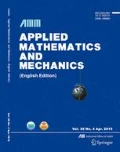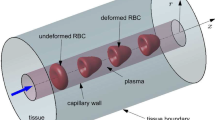Abstract
The entire process of oxygen transport in microcirculation by developing a 3D porous media model is calculated numerically with coupled solid deformation-fluid seepage-convection and diffusion. The principal novelty of the model is that it takes into account volumetric deformation of both capillary and tissues resulting from capillary fluctuation. How solid deformation, fluid seepage, and convection-diffusion combine to affect oxygen transport is examined quantitatively: (1) Solid deformation is more significant in the middle of capillary, where the maximum value of volumetric deformation reaches about 0.5%. (2) Solid deformation has positive influence on the tissue fluid so that it flows more uniformly and causes oxygen to be transported more uniformly, and eventually impacts oxygen concentration by 0.1%–0.5%. (3) Convection-diffusion coupled deformation and seepage has a maximum (16%) and average (3%) increase in oxygen concentration, compared with pure molecular diffusion. Its more significant role is to allow oxygen to be transported more evenly.
Similar content being viewed by others
References
Pittman, R. N. Oxygen gradients in the microcirculation. Acta Physiologica, 202(3), 311–322 (2011)
Skalak, R. Mechanics of the Microcirculation, 1st ed., Prentice-Hall, New Jersey, 457–499 (1971)
Den Uil, C. A., Klijn, E., Lagrand, W. K., Brugts, J. J., Ince, C., Spronk, P. E., and Simoons, M. L. The microcirculation in health and critical disease. Progress in Cardiovascular Diseases, 51(2), 161–170 (2008)
Abularrage, C. J., Sidawy, A. N., Aidinian, G., Singh, N., Weiswasser, J. M., and Arora, S. Evaluation of the microcirculation in vascular disease. Journal of Vascular Surgery, 42(5), 574–581 (2005)
Michel, C. C. Handbook of Physiology: the Cardiovascular System, 1st ed., American Physiological Society, Bethesda, 375–410 (1984)
Landis, E. M. and Pappenheimer, J. R. Handbook of Physiology: Circulation, 1st ed., American Physiological Society, Washington D. C., 961–1034 (1963)
Krogh, A. The number and distribution of capillaries in muscles with calculations of the oxygen pressure head necessary for supplying the tissue. The Journal of Physiology, 52(6), 409–415 (1919)
Krogh, A. The supply of oxygen to the tissues and the regulation of the capillary circulation. The Journal of Physiology, 52(6), 457–474 (1919)
Middleman, S. Transport Phenomena in the Cardiovascular System, Wiley-InterScience, New York, 116–140 (1972)
Goldman, D. Theoretical models of microvascular oxygen transport to tissue. Microcirculation 15(8), 795–811 (2008)
Popel, A. S. Theory of oxygen transport to tissue. Critical Reviews in Biomedical Engineering, 17(3), 257–321 (1989)
Pittman, R. N. Regulation of Tissue Oxygenation, 1st ed., Morgan and Claypool Life Sciences, San Rafael, 1–100 (2011)
Greene, A. S., Tonellato, P. J., Zhang, Z., Lombard, J. H., and Cowley, A. J. Effect of microvascular rarefaction on tissue oxygen delivery in hypertension. American Journal of Physiology, 262(5), 1486–1493 (1992)
McGuire, B. J. and Secomb, T. W. A theoretical model for oxygen transport in skeletal muscle under conditions of high oxygen demand. Journal of Applied Physiology, 91(5), 2255–2265 (2001)
Mikelic, A. and Primicerio, M. A diffusion-consumption problem for oxygen in a living tissue perfused by capillaries. Nonlinear Differential Equations and Applications, 13(3), 349–367 (2006)
Yulianti, K. and Gunawan, A. Y. An asymptotic study for the steady model of oxygen diffusion in tissue region. ITB Journal of Science, 44(2), 164–178 (2012)
Grinberg, O., Novozhilov, B., Grinberg, S., Friedman, B., and Swartz, H. M. Axial oxygen diffusion in the Korgh model: modifications to account for myocardial oxygen tension in isolated perfused rat hearts measured by EPR oximetry. Advances in Experimental Medicine and Biology, 566, 127–134 (2005)
Titcombe, M. S., Titcombe, E. S., and Michael, M. J. An asymptotic study of oxygen transport from multiple capillaries to skeletal muscle tissue. Journal of Applied Mathematics, 60(5), 1767–1788 (2000)
Salathe, E. P. Mathematical analysis of oxygen concentration in a two dimensional array of capillaries. Journal of Mathematical Biology, 46(4), 287–308 (2003)
Sharma, G. C. and Jain, M. A computational solution of mathematical model for oxygen transport in peripheral nerve. Computers in Biology and Medicine, 34(7), 633–645 (2004)
Hellums, J. D., Nair, P. K., Huang, N. S., and Oshima, N. Simulation of intraluminal gas transport in the microcirculation. Annals of Biomedical Engineering, 24(1), 1–24 (1996)
Moschandreou, T. E., Ellis, C. G., and Goldman, D. Influence of tissue metabolism and capillary oxygen supply on arteriolar oxygen transport: a computational model. Mathematical Biosciences, 232(1), 1–10 (2011)
Pozrikidis, C. and Farrow, D. A. A model of fluid flow in solid tumors. Annals of Biomedical Engineering, 31(2), 181–194 (2003)
Pozrikidis, C. Numerical simulation of blood and interstitial flow through a solid tumor. Journal of Mathematical Biology, 60(1), 75–94 (2010)
Chapman, S. J., Shipley, R. J., and Jawad, R. Multiscale modeling of fluid transport in tumors. Bulletin of Mathematical Biology, 70(8), 2334–2357 (2008)
Wang, P. and Olbricht, W. L. Retro-convection enhanced drug delivery: a computational study. Annals of Biomedical Engineering, 38(8), 2512–2519 (2010)
Schuff, M. M., Gore, J. P., and Nauman, E. A. A mixture theory model of fluid and solute transport in the microvasculature of normal and malignant tissues, I, theory. Journal of Mathematical Biology, 66(6), 1179–1207 (2013)
Schuff, M. M., Gore, J. P., and Nauman, E. A. A mixture theory model of fluid and solute transport in the microvasculature of normal and malignant tissues, II, factor sensitivity analysis, calibration, and validation. Journal of Mathematical Biology, 67(6–7), 1307–1337 (2013)
Pittman, R. N. Oxygen transport in the microcirculation and its regulation. Microcirculation, 20(2), 117–137 (2013)
Popel, A. S., Goldman, D., and Vadapalli, A. Modeling of oxygen diffusion from the blood vessels to intracellular organelles. Advances in Experimental Medicine and Biology, 530, 485–495 (2003)
Yao, H. and Gu, W. Y. Convection and diffusion in charged hydrated soft tissue: a mixture theory approach. Biomechanics and Modeling in Mechanobiology, 6(1–2), 63–72 (2007)
Byrne, H. and Preziosi, L. Modelling solid tumour growth using the theory of mixtures. Mathematical Medicine and Biology, 20(4), 341–366 (2003)
Zweifach, B. W. Quantitative studies of microcirculatory structure and function, II, direct measurement of capillary pressure in splanchnic mesenteric vessels. Circulation Research, 34(6), 858–866 (1974)
Bear, J. Dynamics of Fluids in Porous Media, Elsevier, New York (1988)
Hall, J. E. Guyton and Hall Textbook of Medical Physiology, 12th ed., Elsevier Saunders, New York, 495–504 (2010)
Casciari, J. J., Sotirchos, S. V., and Sutherland, R. M. Variation in tumour cell growth rates and metabolism with oxygen-concentration, glucose-concentration and extracellar pH. Journal of Cellular Physiology, 151(2), 386–394 (1992)
Anderson, A. R. A. A hybrid mathematical model of solid tumor invasion: the importance of cell adhesion. Mathematical Medicine and Biology, 22(2), 163–186 (2005)
Caro, C. G., Pedley, T. J., Schroter, R. C., and Seed, W. A. The Mechanics of the Circulation, 2nd ed., Oxford University Press, Cambridge, 368–372 (2012)
He, Y. and Himeno, R. Finite element analysis on fluid filtration in system of permeable curved capillary and tissue. Journal of Mechanics in Medicine and Biology, 12(4), 1250077 (2012)
Liu, G., Gabhann, F. M., and Popel, A. S. Effect of fiber type and size on the heterogeneity of oxygen distribution in exercising Skeletal muscle. PLoS ONE, 7(9), 44375 (2012)
Cai, Y., Xu, S., Wu, J., and Long, Q. Coupled modeling of tumor growth and blood perfusion. Journal of Theoretical Biology, 279(1), 90–101 (2011)
Zhu, Q., Zhang, A., Liu, P. X., and Xu, L. Study of tumor growth under hyperthermia condition. Computational and Mathematical Methods in Medicine, 2012, 198145 (2012)
Macklin, P. and Lowengrub, J. Nonlinear simulation of the effect of microenvironment on tumor growth. Journal of Theoretical Biology, 245(4), 677–704 (2007)
Author information
Authors and Affiliations
Corresponding author
Rights and permissions
About this article
Cite this article
Zhao, N., Iramina, K. Numerical simulation of effect of convection-diffusion on oxygen transport in microcirculation. Appl. Math. Mech.-Engl. Ed. 36, 179–200 (2015). https://doi.org/10.1007/s10483-015-1908-7
Received:
Revised:
Published:
Issue Date:
DOI: https://doi.org/10.1007/s10483-015-1908-7




